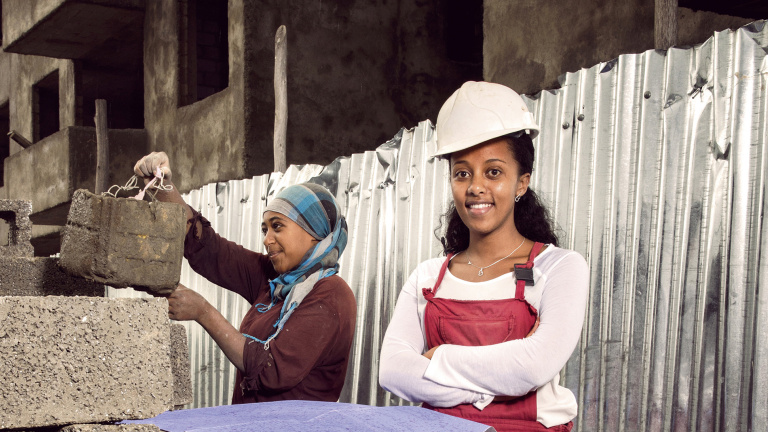
Agricultural value chains and their potential for youth employment in fragile and conflict-affected contexts
As agriculture is one of the most promising sectors in most fragile and conflict-affected environments, this article explores some of the key challenges and obstacles agricultural value chain development poses for youth employment.
Increased attention for the challenges and potential of youth employment
Attention to the challenges and opportunities of youth employment is not new. In 2012, the African Development Bank (AfDB) and the OECD released a dedicated study about youth employment in Africa, noting: “creating productive employment for Africa’s rapidly growing young population is an immense challenge, but also the key to future prosperity”. The potential of agriculture for youth employment has, however, received more recent attention. The African Union’s 2014 Malabo Declaration on Agriculture, for instance, underlines the importance of agriculture and youth employment in agri-business for poverty reduction objectives.
Outside Africa as well, the issue receives increasing attention. The European Union’s External Investment Plan (EIP), launched in September 2016, includes a focus on employment creation for youth as a means to tackle the root causes of migration and fragility. With youth at the top of the agenda for the upcoming Africa-EU summit scheduled in November 2017, the potential for youth employment and agricultural value chain development in fragile contexts deserves a closer look.
Re-building fragile relations
Value chain development and agricultural investment are generally challenging development interventions, and even more so in fragile or conflict-affected areas. Hiller, Hilhorst and Weijs (2014) note that, in fragile contexts, value chains are generally inefficient and short, which in turn results in an unequal distribution of income across the chain. Meanwhile, however, the World Bank (2013) and other experts have pointed to the peacebuilding and developmental potential of investing in agricultural value chain development in fragile and conflict-affected states. Value chain development notably strengthens the relationships between different stakeholders across the chain, relationships which are generally weak in conflict-ridden and fragile environments. Focusing on the multiple entry points along the value chain, each characterised by interaction and interdependence, arguably allows for conflict sensitive development approaches.
Youth unemployment and fragility
At the same time, youth unemployment continues to be seen as a major concern in view of potential security threats in fragile contexts, and constitutes one of the economic indicators of the OECD’s fragility framework used to assess the fragility of states and contexts across five dimensions. The linkages between youth un- or underemployment and violence and instability are diverse and complex, and are therefore often misunderstood. In some cases, such limited understanding of the matter has led to an overconfidence in employment creation as a panacea for peaceful reintegration (International Alert, 2014). Despite diverging views on how and why youths pose a threat in fragile and post-conflict contexts, it is clear that the future youth bulge in Africa poses major challenges in terms of employment creation in the decades to come.
Agricultural potential in fragile and conflict-affected environments
According to the World Bank (2013) informal economies and agriculture constitute the two most promising sectors in terms of job creation in most fragile and conflict-affected states on the continent. Rural-urban migration patterns among young Africans, however, seem to reflect a reluctance to engage in agricultural work. In a similar vein, youths from rural areas who have been forced to migrate to urban areas due to instability, conflict or the collapse of rural economies, often prefer not to return given the limited employment prospects. International Alert (2014) notes in this regard that young people’s rejection of village life and agricultural labour often extends beyond mere employment preferences but also has to do with the socio-political institutions associated with rural subsistence farming. Indeed, as Raeymaekers (2011) has pointed out, youths often reject an agricultural lifestyle as a result of intergenerational conflict, and find themselves blocked from access to land and trading networks by (older) gatekeepers.
Given the predominance and potential of the informal and agricultural sectors in Africa, however, efforts to promote more qualitative employment opportunities for youths in agricultural value chains in fragile contexts hold much promise. One of the objectives of the European External Investment Plan is to guarantee private sector investment “in contexts that are politically more risky than others”. The 2014 Malabo Declaration vows to a) create job opportunities for at least 30% of the youth in agricultural value chains and b) to support and facilitate preferential entry and participation for women and youth in gainful and attractive agri-business opportunities.
Operationalising a conflict-sensitive approach to agricultural value chains
It is less obvious, however, how both policy processes will operationalise a conflict-sensitive approach to agricultural value chain development and youth employment in fragile and conflict-affected environments. While the renewed attention from European and African policy makers confirms the potential for youth employment in informal and agricultural sectors, the contexts in which these value chains develop are extremely varied across the continent. Applying a conflict-sensitive approach and taking into account the potential impact of fragility (including violent conflict) on value chains will be key to operationalise a long-term sustainable and inclusive approach to youth employment.
The stakes are high: Africa is a young continent, with half of its population currently under the age of 18. Meanwhile, fertility decline remains slow, even as life expectancy improves. Africa moreover continues to face the highest level of violent conflict (together with the Middle East), and the majority of fragile contexts identified in the OECD’s 2016 fragility assessment are situated in African countries. With youth as a key priority for the upcoming Africa-EU summit, there is an opportunity for policy makers to pay due attention to both the challenges and the potential agricultural value chain development offers for youth employment creation in fragile contexts across the continent.
The author would like to thank Paulina Bizzoto Molina for her comments and suggestions for this contribution.
References
African Development Bank, Organisation for Economic Co-operation and Development, United Nations Development Programme, United Nations Economic Commission for Africa. 2012. African Economic Outlook 2012 – Special Theme: Promoting Youth Employment.
Batmanglich, S. and L. Enria. 2014. Real Jobs in Fragile Countries, Reframing youth employment programming in Liberia and Sierra Leone. International Alert.
Dudwick, N, R. Srinivasan, J. Cuesta and D. Madani. 2013. Creating jobs in Africa’s fragile states: are value chains an answer? Directions in development: countries and regions. Washington DC; World Bank.
Hiller, S., D. Hilhorst and B. Weijs. 2014. Value chain development in Fragile Settings. Occasional Paper #14, Wageningen University.
OECD. 2016. States of Fragility 2016: Understanding Violence. OECD Publishing. Paris.
Raeymaekers, T. 2011. Forced Displacement and Youth Employment in the Aftermath of the Congo War: From Making a Living to Making a Life. MICROCON Research Working Paper 38, Institute of Development Studies, University of Sussex, Brighton, UK.
About the author
Sophie Desmidt is a Policy Officer in ECDPM’s Security and Resilience programme.
Read the full magazine issue






